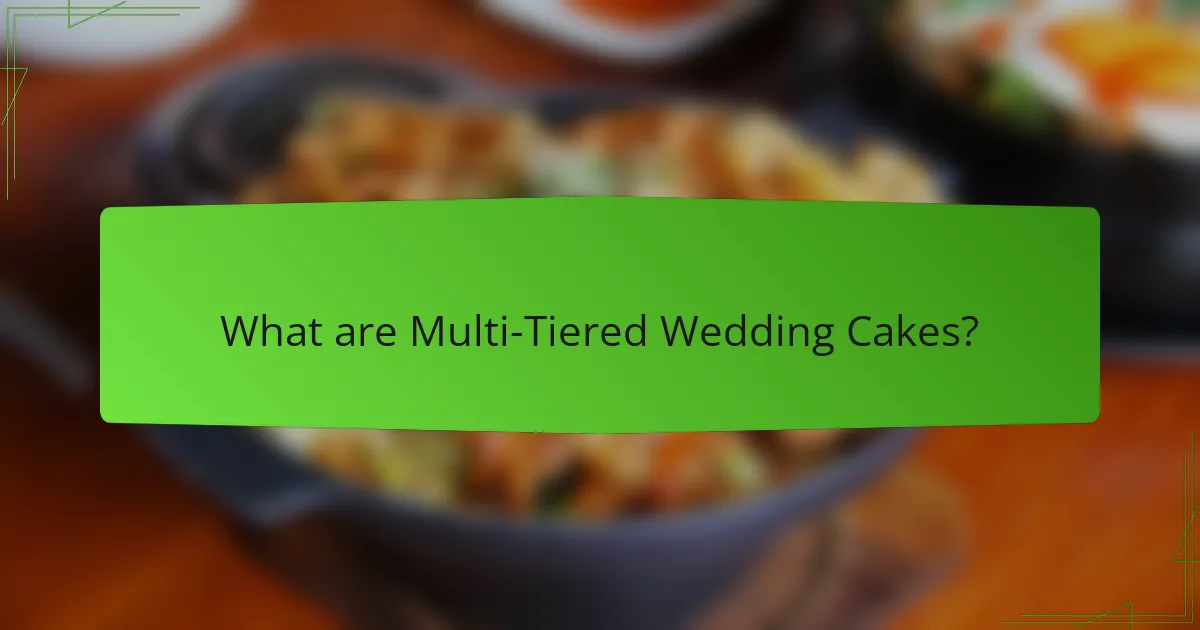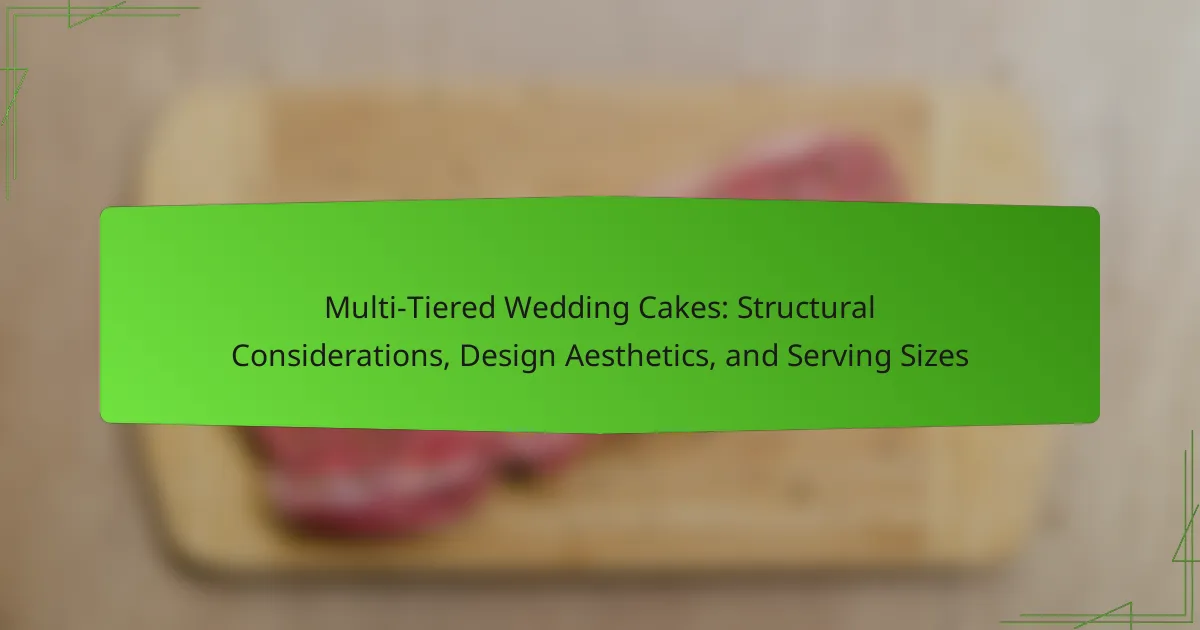
What are Multi-Tiered Wedding Cakes?
Multi-tiered wedding cakes are cakes consisting of multiple layers stacked on top of each other. Each tier can be a different flavor or design, allowing for customization. These cakes often serve as the centerpiece of wedding receptions. The structure typically requires support systems to hold the weight of the tiers. Common materials for support include dowels or central rods. Multi-tiered cakes can range from two to several tiers high. The design often reflects the wedding theme or couple’s preferences. They are traditionally cut and served to guests during the reception.
How are Multi-Tiered Wedding Cakes constructed?
Multi-tiered wedding cakes are constructed by stacking multiple layers of cake. Each layer is typically made from cake boards for support. The cakes are baked in different sizes, usually ranging from 6 inches to 14 inches in diameter. After baking, the cakes are cooled and leveled to ensure stability.
A dowel rod system is often used to support the upper tiers. This prevents the weight of the upper layers from collapsing the lower ones. Frosting or fondant is applied between the layers for adhesion and aesthetics. Finally, the entire cake is decorated according to the desired design.
This method ensures both structural integrity and visual appeal. Proper construction techniques are crucial for the cake to remain stable during transport and display.
What materials are commonly used in Multi-Tiered Wedding Cake construction?
Common materials used in multi-tiered wedding cake construction include cake boards, dowels, and fondant. Cake boards provide a sturdy base for each tier. Dowels are inserted for structural support, preventing the tiers from collapsing. Fondant is often used for a smooth finish and decorative elements. Other materials may include buttercream for frosting and various edible decorations. These components ensure stability and aesthetic appeal in multi-tiered cakes.
How does the structure of a Multi-Tiered Wedding Cake affect its stability?
The structure of a multi-tiered wedding cake significantly affects its stability. Each tier adds weight and requires proper support to prevent collapsing. The use of dowels or supports between tiers distributes the weight evenly. This prevents the lower tiers from being crushed by the weight of the upper ones. Additionally, the base of the cake must be sturdy enough to support the entire structure. Cakes with a wider base are generally more stable. The choice of cake materials also impacts stability. Dense cakes, like fruitcake, provide better support than lighter options. Proper stacking techniques further enhance stability, ensuring the cake remains intact during transport and display.
What design aesthetics are popular for Multi-Tiered Wedding Cakes?
Popular design aesthetics for multi-tiered wedding cakes include classic, modern, rustic, and whimsical styles. Classic designs often feature smooth fondant finishes and elegant piping. Modern aesthetics may incorporate geometric shapes and bold colors. Rustic cakes typically showcase textured buttercream and natural elements like flowers. Whimsical designs often include playful themes and unique decorations. Each aesthetic caters to different wedding themes and personal preferences. The choice of design impacts the overall visual appeal and guest experience.
What are the trending styles for Multi-Tiered Wedding Cakes?
Trending styles for multi-tiered wedding cakes include [censured] cakes, geometric designs, and floral accents. [censured] cakes feature minimal frosting, showcasing the cake layers and fillings. Geometric designs incorporate sharp lines and modern shapes, appealing to contemporary aesthetics. Floral accents use fresh or sugar flowers to create a romantic look. Watercolor effects add a soft, artistic touch to cake surfaces. Metallic finishes, such as gold or silver leaf, provide a luxurious appearance. Ombre designs transition colors smoothly across tiers, creating visual interest. Lastly, rustic styles emphasize natural textures and earthy colors, aligning with outdoor or barn weddings.
How do color schemes influence the design of Multi-Tiered Wedding Cakes?
Color schemes significantly influence the design of multi-tiered wedding cakes. They affect visual appeal and convey the wedding’s theme. For example, a pastel palette creates a soft, romantic look. In contrast, bold colors can make a striking statement. Color combinations also dictate the choice of decorative elements. They guide the selection of flowers, ribbons, and cake toppers. Additionally, colors can enhance the perceived size of the cake. Light colors may make a cake appear larger, while dark shades can create a more compact look. Ultimately, color schemes play a crucial role in the overall aesthetic coherence of the wedding celebration.
What are the serving sizes for Multi-Tiered Wedding Cakes?
The serving sizes for multi-tiered wedding cakes typically range from 30 to 100 servings. The number of servings depends on the size and number of tiers. A standard serving size of wedding cake is about 1 inch by 2 inches. For a three-tiered cake, the bottom tier is usually the largest and can serve the most guests. A 10-inch bottom tier can serve approximately 38 guests. An 8-inch middle tier serves around 24 guests. A 6-inch top tier typically serves about 12 guests. These estimates can vary based on cake design and cutting methods.
How can one calculate the number of servings from a Multi-Tiered Wedding Cake?
To calculate the number of servings from a multi-tiered wedding cake, determine the size of each tier. Standard serving sizes vary, but typically, a 1-inch by 2-inch slice is considered a serving. Measure the diameter and height of each tier. Use the formula for volume to find the total cake volume. The volume can be calculated using the formula for a cylinder: V = πr²h, where r is the radius and h is the height.
After calculating the volume of each tier, divide by the average serving size volume. For example, if a standard serving is approximately 4 cubic inches, divide the total volume by 4. This will give the total number of servings for the cake.
If the cake has different tier sizes, repeat the calculation for each tier and sum the servings for a total count. This method ensures an accurate estimate of servings based on the cake’s dimensions.
What factors affect the serving size of a Multi-Tiered Wedding Cake?
The serving size of a multi-tiered wedding cake is affected by several factors. The number of tiers plays a crucial role; more tiers typically mean more servings. Cake size and shape also influence servings; larger or wider cakes yield more slices. The type of cake impacts serving size; denser cakes may require smaller portions compared to lighter cakes. Additionally, the serving style matters; plated servings differ from buffet-style servings, affecting portion sizes. Lastly, guest count determines overall servings; more guests require a larger cake to ensure everyone is served.
How do structural considerations impact the overall design of Multi-Tiered Wedding Cakes?
Structural considerations significantly impact the overall design of multi-tiered wedding cakes. These considerations ensure the cake’s stability and aesthetic appeal. Proper support systems, such as dowels and plates, are crucial for holding the weight of upper tiers. Without adequate support, cakes risk collapsing or becoming unbalanced. The choice of materials also influences design; heavier cakes require stronger structures. Additionally, the distribution of weight affects the visual proportions of the cake. Designers must account for the height and width of each tier to maintain stability. Overall, structural integrity is essential for both functionality and visual harmony in multi-tiered wedding cakes.
What are the common challenges faced when designing Multi-Tiered Wedding Cakes?
Common challenges faced when designing multi-tiered wedding cakes include structural stability, weight distribution, and moisture retention. Ensuring the cake can support its own weight is critical. Each tier adds additional weight, which can lead to collapsing if not properly supported. Weight distribution must be considered in the design to avoid tilting or falling.
Moisture retention is another challenge, as cakes can dry out between layers. Proper sealing and storage methods are necessary to maintain freshness. Additionally, achieving a cohesive design across multiple tiers can be difficult. Each tier may require different decorations or flavors, complicating the overall aesthetic.
Transporting multi-tiered cakes poses risks of damage. Careful planning and packaging are essential for safe delivery. Finally, meeting the specific serving size requirements for guests can be challenging due to varying tier sizes. Accurate calculations are necessary to ensure everyone is served adequately.
How can one overcome stability issues in Multi-Tiered Wedding Cakes?
To overcome stability issues in multi-tiered wedding cakes, use dowels or supports between layers. Dowels provide essential support to prevent collapsing. Insert them into the bottom layer before adding the next tier. Ensure the dowels are cut to the same height as the cake. Additionally, use a sturdy cake board beneath each tier for added stability. A strong buttercream or ganache can also help adhere layers together. Refrigerating the cake before transport can solidify the structure. Lastly, ensure the cake is placed on a flat surface to prevent tilting. These methods have been proven effective in maintaining the integrity of multi-tiered cakes during serving.
What are the best practices for decorating Multi-Tiered Wedding Cakes?
The best practices for decorating multi-tiered wedding cakes include ensuring structural integrity, using appropriate supports, and selecting cohesive design elements. First, use dowels or cake boards to support each tier. This prevents collapsing and maintains stability. Second, choose a color palette and theme that aligns with the wedding’s overall aesthetic. This creates a harmonious look. Third, incorporate various textures and decorations, such as fondant, buttercream, or fresh flowers. These add visual interest. Fourth, consider the size and shape of each tier to ensure balance. Lastly, apply decorations in layers, starting from the bottom and working upwards. This method allows for easier adjustments and a polished finish.
What tips should one consider when planning a Multi-Tiered Wedding Cake?
When planning a multi-tiered wedding cake, consider the structural integrity first. Use sturdy supports like dowels or cake boards for each tier. This prevents the cake from collapsing under its own weight. Choose cake flavors that complement each other to enhance the overall taste. Ensure the design aligns with the wedding theme for visual coherence. Calculate the serving sizes accurately to avoid running short on portions. Opt for a balance between decorative elements and cake layers to maintain taste. Consider the transportation logistics to keep the cake intact before the event. Lastly, allow adequate time for baking and decorating to ensure quality.
Multi-tiered wedding cakes are elaborate confections featuring multiple layers stacked for both structural stability and aesthetic appeal. This article delves into the construction techniques, materials used, and design aesthetics that define these cakes, highlighting key factors such as stability, serving sizes, and popular trends. It also addresses common challenges faced during the design process and offers best practices for decoration and planning. By understanding these elements, couples can create a stunning centerpiece that aligns with their wedding theme while ensuring adequate servings for their guests.
